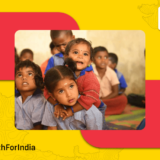
Ray Of Hope Part 1 – A rise of digital education in India
As an SBI YFI Fellow, I have the opportunity to work on projects that align with my interests and the needs of the rural community. I am currently working with BAIF in Shahpur block, Betul district, Madhya Pradesh, India on a project to provide basic computer education to villagers in two villages - Silpatti and Rathamaati/Khokra. This forest region is predominantly inhabited by Gond and Korku tribes.
The Need for Digital Education in India

The Government of India has provided each panchayat building with a computer system, complete with a printer and scanner. However, in many of the panchayats I have visited in Shahpur block, the computer system is either disused, missing, or not in working condition. In some cases, the computer is lying in a panchayat member's house, and in one case, the computer was disused because the panchayat house had no electricity connection.
The Government of India is moving all government operations online. All government data, excluding secret information, is now available online. This includes land records, government official contact information, and form submissions for various government schemes, such as Swachh Bharat Mission and sprinkler subsidies. The computers have been provided by the government to make these services and information accessible to every village.
However, in almost all the villages I visited, hardly anyone knew how to use a computer, including the panchayat members and the government appointee in the panchayat. This leads to the computer system being unused and unappreciated.
The Project
Closing the gap between possibility and actuality requires vision, strategy, and execution.
- Robin S. Sharma.
There is a significant gap between the Government of India's digital initiatives and the villagers' ability to go digital. This gap is not infrastructure but knowledge. The tools to go digital have been provided, but the knowledge to use them has not. My project aims to bridge this knowledge gap by providing computer education. The curriculum will cover computer basics, internet basics, and basic search engine usage. After the course is completed, I will document changes in government scheme availabilities, increase in general awareness, and the villagers' willingness to learn computers.
Also Read: Life Skills Training for Youth: A Solution to Stable Income
Progress So Far

The progress of the project has had its ups and downs. I started by visiting the panchayats where BAIF is active. The first panchayat I visited did not have electricity, the second did not have a computer, and the third had a broken computer. However, the fourth panchayat had a computer and internet connectivity, which was a relief. I talked to the sarpanch, who was a friendly lady, and obtained her agreement for using the panchayat house and computer for the project. During the Gram Sabha held on Republic Day, I talked to the villagers about my project and received an enthusiastic response. I got as many as 12 names for the course, but when I started taking classes, no one turned up.
Overall, the project has faced challenges, but I am determined to keep going and make a difference in these villages by providing digital education in India.
Despite the setbacks, I am still optimistic and determined to succeed in my project. I know that it won’t be an easy journey, but I also know that it will be worth it. I am already seeing small victories, like the villagers showing an interest in learning how to use the computer and how it can benefit them. I believe that with time, more and more villagers will join the course, and the knowledge gap between the government's digital initiative and the villagers will slowly start to close.
Also Read: Importance of Girl Child Education - Investing in the Future
Conclusion:
Digital education in India is the future, and it’s crucial for the rural communities in India to be a part of this future. The government has taken a step in the right direction by providing computers to each Panchayat building, but the knowledge to use these tools is equally important. Through my project, I hope to bridge the knowledge gap and help the villagers in Shahpur block, Madhya Pradesh, to join the digital age.
Education is the most powerful tool you can use to change the world.
– Nelson Mandela.
Read the 2nd part: Ray of hope Part 2 – A rise of digital education in India
By Mehak Aggarwal


